Operations Management: Capacity, Inventory, and Supply Chain Analysis
VerifiedAdded on 2020/03/01
|12
|3041
|44
Report
AI Summary
This report provides a comprehensive analysis of key concepts in operations management, focusing on capacity planning, inventory management, and supply chain strategies. The report begins by defining and explaining capacity planning, including its importance, determinants, and utilization calculations. It then explores various capacity strategies, such as lead, lag, match, and adjustment strategies, and how they can be applied to improve supply. The second part of the report delves into inventory management, including its importance, costs, and the Economic Order Quantity (EOQ) model. It also covers different inventory control systems like fixed order and variable period systems, and the Just-in-Time (JIT) approach. The final section examines supply chain management, defining its processes and outlining current trends, with a focus on fast-moving consumer goods and a flowchart representing a plumbing supply chain. The report offers practical insights and recommendations for improving operational efficiency and supply chain performance.
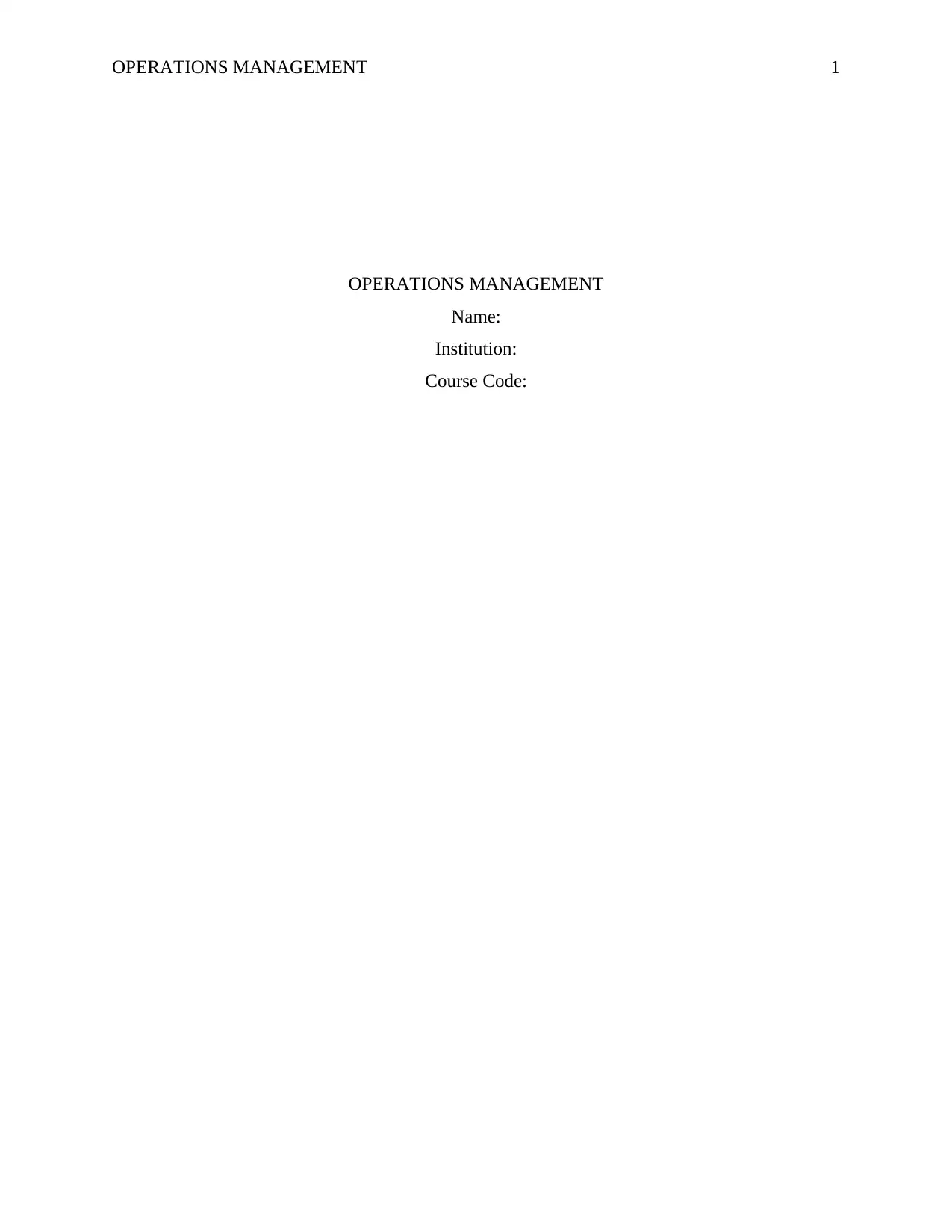
OPERATIONS MANAGEMENT 1
OPERATIONS MANAGEMENT
Name:
Institution:
Course Code:
OPERATIONS MANAGEMENT
Name:
Institution:
Course Code:
Paraphrase This Document
Need a fresh take? Get an instant paraphrase of this document with our AI Paraphraser
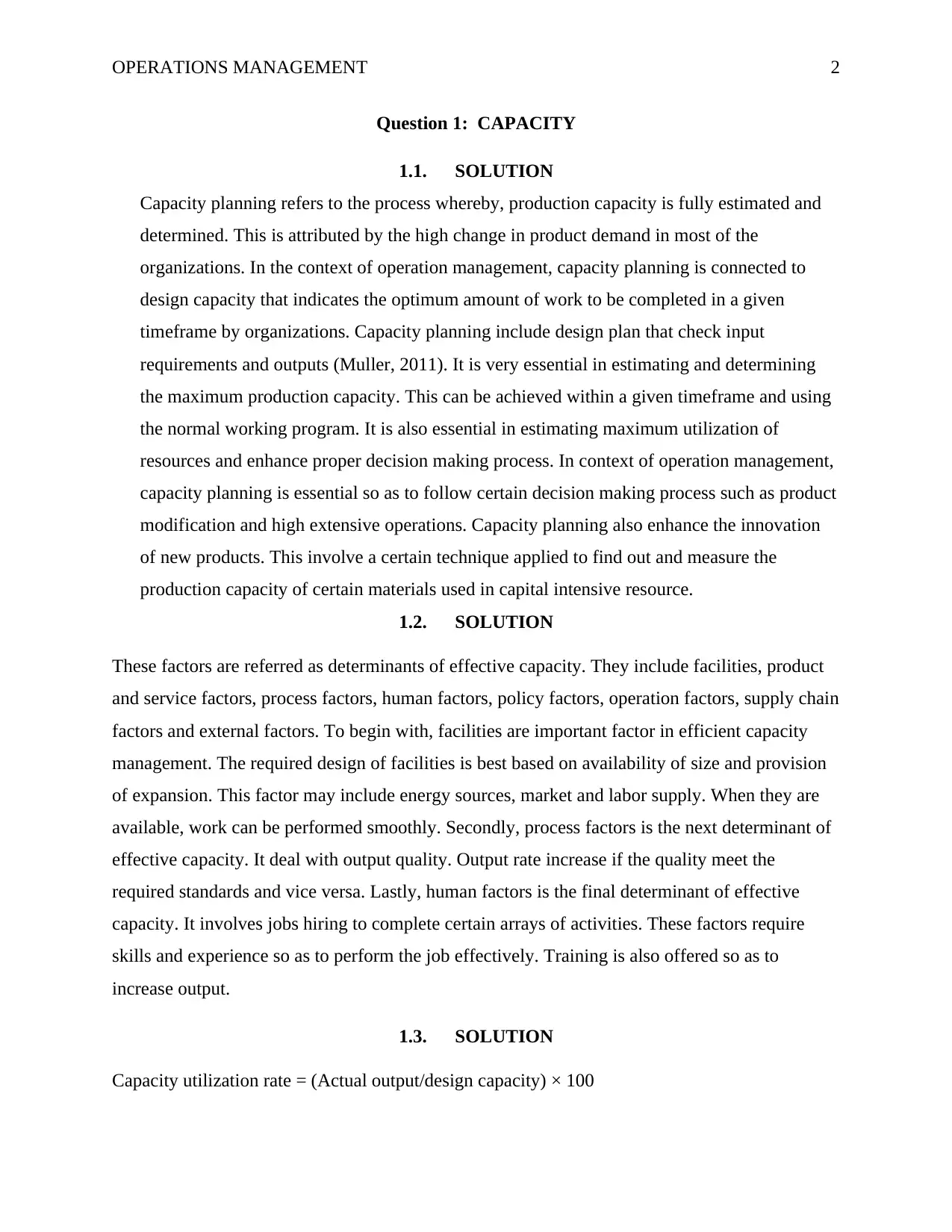
OPERATIONS MANAGEMENT 2
Question 1: CAPACITY
1.1. SOLUTION
Capacity planning refers to the process whereby, production capacity is fully estimated and
determined. This is attributed by the high change in product demand in most of the
organizations. In the context of operation management, capacity planning is connected to
design capacity that indicates the optimum amount of work to be completed in a given
timeframe by organizations. Capacity planning include design plan that check input
requirements and outputs (Muller, 2011). It is very essential in estimating and determining
the maximum production capacity. This can be achieved within a given timeframe and using
the normal working program. It is also essential in estimating maximum utilization of
resources and enhance proper decision making process. In context of operation management,
capacity planning is essential so as to follow certain decision making process such as product
modification and high extensive operations. Capacity planning also enhance the innovation
of new products. This involve a certain technique applied to find out and measure the
production capacity of certain materials used in capital intensive resource.
1.2. SOLUTION
These factors are referred as determinants of effective capacity. They include facilities, product
and service factors, process factors, human factors, policy factors, operation factors, supply chain
factors and external factors. To begin with, facilities are important factor in efficient capacity
management. The required design of facilities is best based on availability of size and provision
of expansion. This factor may include energy sources, market and labor supply. When they are
available, work can be performed smoothly. Secondly, process factors is the next determinant of
effective capacity. It deal with output quality. Output rate increase if the quality meet the
required standards and vice versa. Lastly, human factors is the final determinant of effective
capacity. It involves jobs hiring to complete certain arrays of activities. These factors require
skills and experience so as to perform the job effectively. Training is also offered so as to
increase output.
1.3. SOLUTION
Capacity utilization rate = (Actual output/design capacity) × 100
Question 1: CAPACITY
1.1. SOLUTION
Capacity planning refers to the process whereby, production capacity is fully estimated and
determined. This is attributed by the high change in product demand in most of the
organizations. In the context of operation management, capacity planning is connected to
design capacity that indicates the optimum amount of work to be completed in a given
timeframe by organizations. Capacity planning include design plan that check input
requirements and outputs (Muller, 2011). It is very essential in estimating and determining
the maximum production capacity. This can be achieved within a given timeframe and using
the normal working program. It is also essential in estimating maximum utilization of
resources and enhance proper decision making process. In context of operation management,
capacity planning is essential so as to follow certain decision making process such as product
modification and high extensive operations. Capacity planning also enhance the innovation
of new products. This involve a certain technique applied to find out and measure the
production capacity of certain materials used in capital intensive resource.
1.2. SOLUTION
These factors are referred as determinants of effective capacity. They include facilities, product
and service factors, process factors, human factors, policy factors, operation factors, supply chain
factors and external factors. To begin with, facilities are important factor in efficient capacity
management. The required design of facilities is best based on availability of size and provision
of expansion. This factor may include energy sources, market and labor supply. When they are
available, work can be performed smoothly. Secondly, process factors is the next determinant of
effective capacity. It deal with output quality. Output rate increase if the quality meet the
required standards and vice versa. Lastly, human factors is the final determinant of effective
capacity. It involves jobs hiring to complete certain arrays of activities. These factors require
skills and experience so as to perform the job effectively. Training is also offered so as to
increase output.
1.3. SOLUTION
Capacity utilization rate = (Actual output/design capacity) × 100
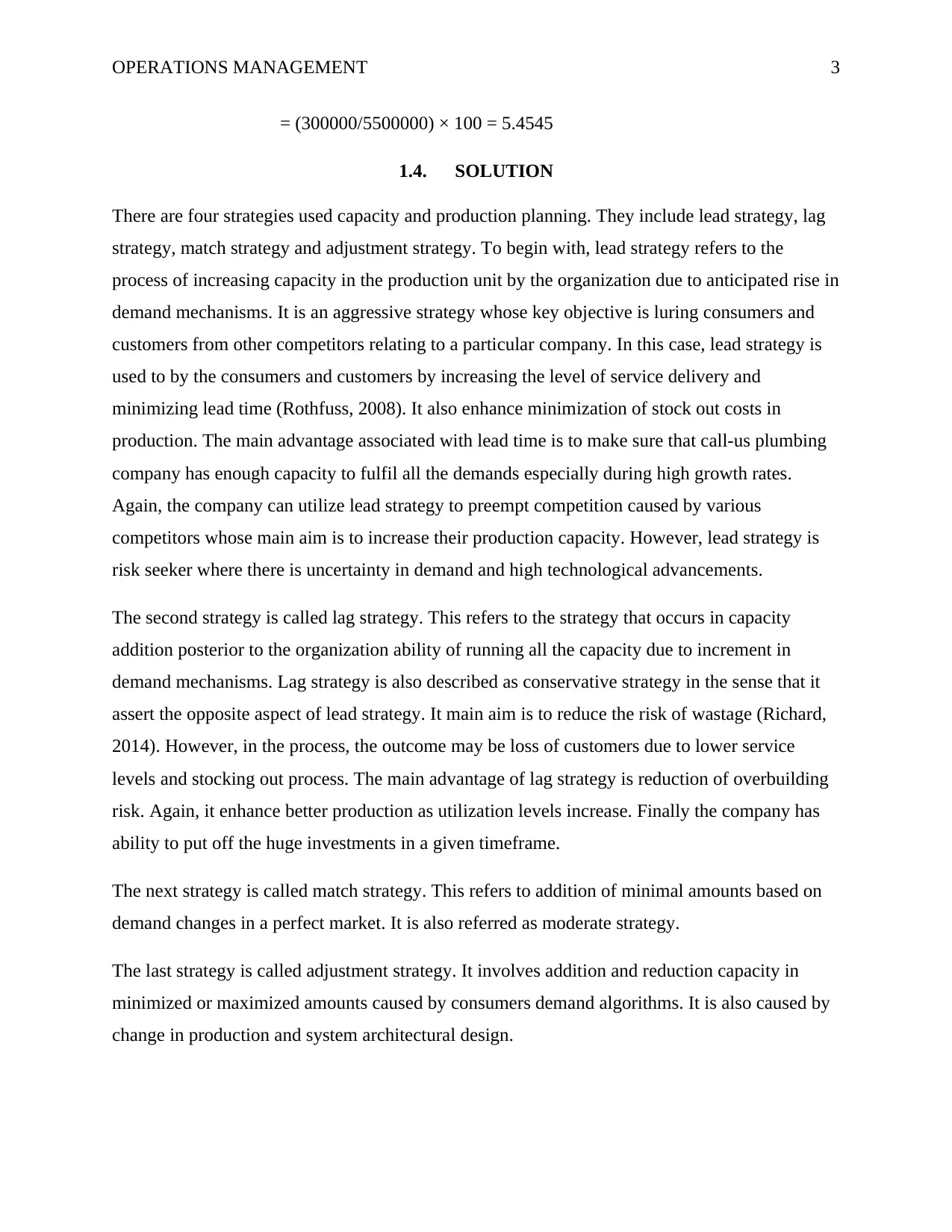
OPERATIONS MANAGEMENT 3
= (300000/5500000) × 100 = 5.4545
1.4. SOLUTION
There are four strategies used capacity and production planning. They include lead strategy, lag
strategy, match strategy and adjustment strategy. To begin with, lead strategy refers to the
process of increasing capacity in the production unit by the organization due to anticipated rise in
demand mechanisms. It is an aggressive strategy whose key objective is luring consumers and
customers from other competitors relating to a particular company. In this case, lead strategy is
used to by the consumers and customers by increasing the level of service delivery and
minimizing lead time (Rothfuss, 2008). It also enhance minimization of stock out costs in
production. The main advantage associated with lead time is to make sure that call-us plumbing
company has enough capacity to fulfil all the demands especially during high growth rates.
Again, the company can utilize lead strategy to preempt competition caused by various
competitors whose main aim is to increase their production capacity. However, lead strategy is
risk seeker where there is uncertainty in demand and high technological advancements.
The second strategy is called lag strategy. This refers to the strategy that occurs in capacity
addition posterior to the organization ability of running all the capacity due to increment in
demand mechanisms. Lag strategy is also described as conservative strategy in the sense that it
assert the opposite aspect of lead strategy. It main aim is to reduce the risk of wastage (Richard,
2014). However, in the process, the outcome may be loss of customers due to lower service
levels and stocking out process. The main advantage of lag strategy is reduction of overbuilding
risk. Again, it enhance better production as utilization levels increase. Finally the company has
ability to put off the huge investments in a given timeframe.
The next strategy is called match strategy. This refers to addition of minimal amounts based on
demand changes in a perfect market. It is also referred as moderate strategy.
The last strategy is called adjustment strategy. It involves addition and reduction capacity in
minimized or maximized amounts caused by consumers demand algorithms. It is also caused by
change in production and system architectural design.
= (300000/5500000) × 100 = 5.4545
1.4. SOLUTION
There are four strategies used capacity and production planning. They include lead strategy, lag
strategy, match strategy and adjustment strategy. To begin with, lead strategy refers to the
process of increasing capacity in the production unit by the organization due to anticipated rise in
demand mechanisms. It is an aggressive strategy whose key objective is luring consumers and
customers from other competitors relating to a particular company. In this case, lead strategy is
used to by the consumers and customers by increasing the level of service delivery and
minimizing lead time (Rothfuss, 2008). It also enhance minimization of stock out costs in
production. The main advantage associated with lead time is to make sure that call-us plumbing
company has enough capacity to fulfil all the demands especially during high growth rates.
Again, the company can utilize lead strategy to preempt competition caused by various
competitors whose main aim is to increase their production capacity. However, lead strategy is
risk seeker where there is uncertainty in demand and high technological advancements.
The second strategy is called lag strategy. This refers to the strategy that occurs in capacity
addition posterior to the organization ability of running all the capacity due to increment in
demand mechanisms. Lag strategy is also described as conservative strategy in the sense that it
assert the opposite aspect of lead strategy. It main aim is to reduce the risk of wastage (Richard,
2014). However, in the process, the outcome may be loss of customers due to lower service
levels and stocking out process. The main advantage of lag strategy is reduction of overbuilding
risk. Again, it enhance better production as utilization levels increase. Finally the company has
ability to put off the huge investments in a given timeframe.
The next strategy is called match strategy. This refers to addition of minimal amounts based on
demand changes in a perfect market. It is also referred as moderate strategy.
The last strategy is called adjustment strategy. It involves addition and reduction capacity in
minimized or maximized amounts caused by consumers demand algorithms. It is also caused by
change in production and system architectural design.
⊘ This is a preview!⊘
Do you want full access?
Subscribe today to unlock all pages.

Trusted by 1+ million students worldwide
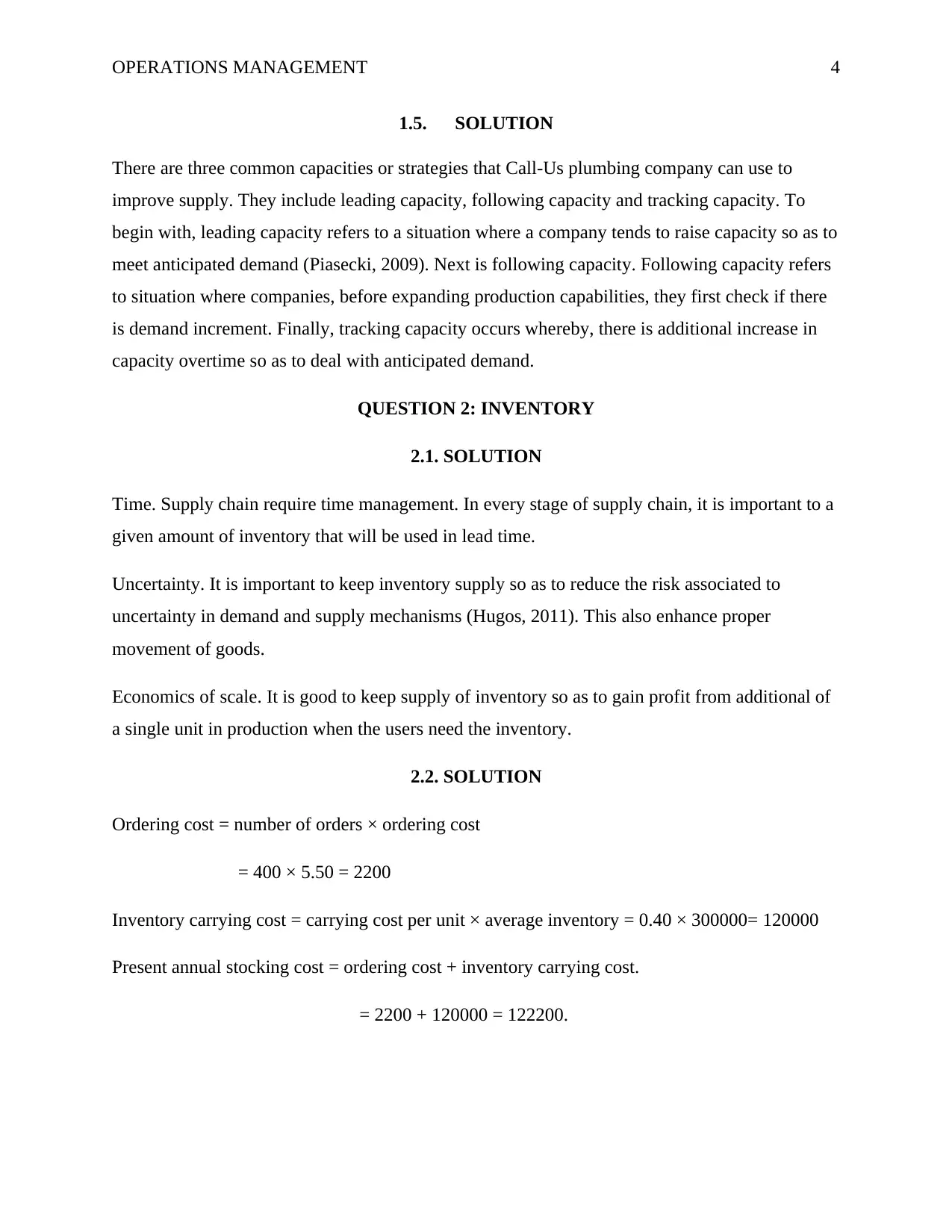
OPERATIONS MANAGEMENT 4
1.5. SOLUTION
There are three common capacities or strategies that Call-Us plumbing company can use to
improve supply. They include leading capacity, following capacity and tracking capacity. To
begin with, leading capacity refers to a situation where a company tends to raise capacity so as to
meet anticipated demand (Piasecki, 2009). Next is following capacity. Following capacity refers
to situation where companies, before expanding production capabilities, they first check if there
is demand increment. Finally, tracking capacity occurs whereby, there is additional increase in
capacity overtime so as to deal with anticipated demand.
QUESTION 2: INVENTORY
2.1. SOLUTION
Time. Supply chain require time management. In every stage of supply chain, it is important to a
given amount of inventory that will be used in lead time.
Uncertainty. It is important to keep inventory supply so as to reduce the risk associated to
uncertainty in demand and supply mechanisms (Hugos, 2011). This also enhance proper
movement of goods.
Economics of scale. It is good to keep supply of inventory so as to gain profit from additional of
a single unit in production when the users need the inventory.
2.2. SOLUTION
Ordering cost = number of orders × ordering cost
= 400 × 5.50 = 2200
Inventory carrying cost = carrying cost per unit × average inventory = 0.40 × 300000= 120000
Present annual stocking cost = ordering cost + inventory carrying cost.
= 2200 + 120000 = 122200.
1.5. SOLUTION
There are three common capacities or strategies that Call-Us plumbing company can use to
improve supply. They include leading capacity, following capacity and tracking capacity. To
begin with, leading capacity refers to a situation where a company tends to raise capacity so as to
meet anticipated demand (Piasecki, 2009). Next is following capacity. Following capacity refers
to situation where companies, before expanding production capabilities, they first check if there
is demand increment. Finally, tracking capacity occurs whereby, there is additional increase in
capacity overtime so as to deal with anticipated demand.
QUESTION 2: INVENTORY
2.1. SOLUTION
Time. Supply chain require time management. In every stage of supply chain, it is important to a
given amount of inventory that will be used in lead time.
Uncertainty. It is important to keep inventory supply so as to reduce the risk associated to
uncertainty in demand and supply mechanisms (Hugos, 2011). This also enhance proper
movement of goods.
Economics of scale. It is good to keep supply of inventory so as to gain profit from additional of
a single unit in production when the users need the inventory.
2.2. SOLUTION
Ordering cost = number of orders × ordering cost
= 400 × 5.50 = 2200
Inventory carrying cost = carrying cost per unit × average inventory = 0.40 × 300000= 120000
Present annual stocking cost = ordering cost + inventory carrying cost.
= 2200 + 120000 = 122200.
Paraphrase This Document
Need a fresh take? Get an instant paraphrase of this document with our AI Paraphraser
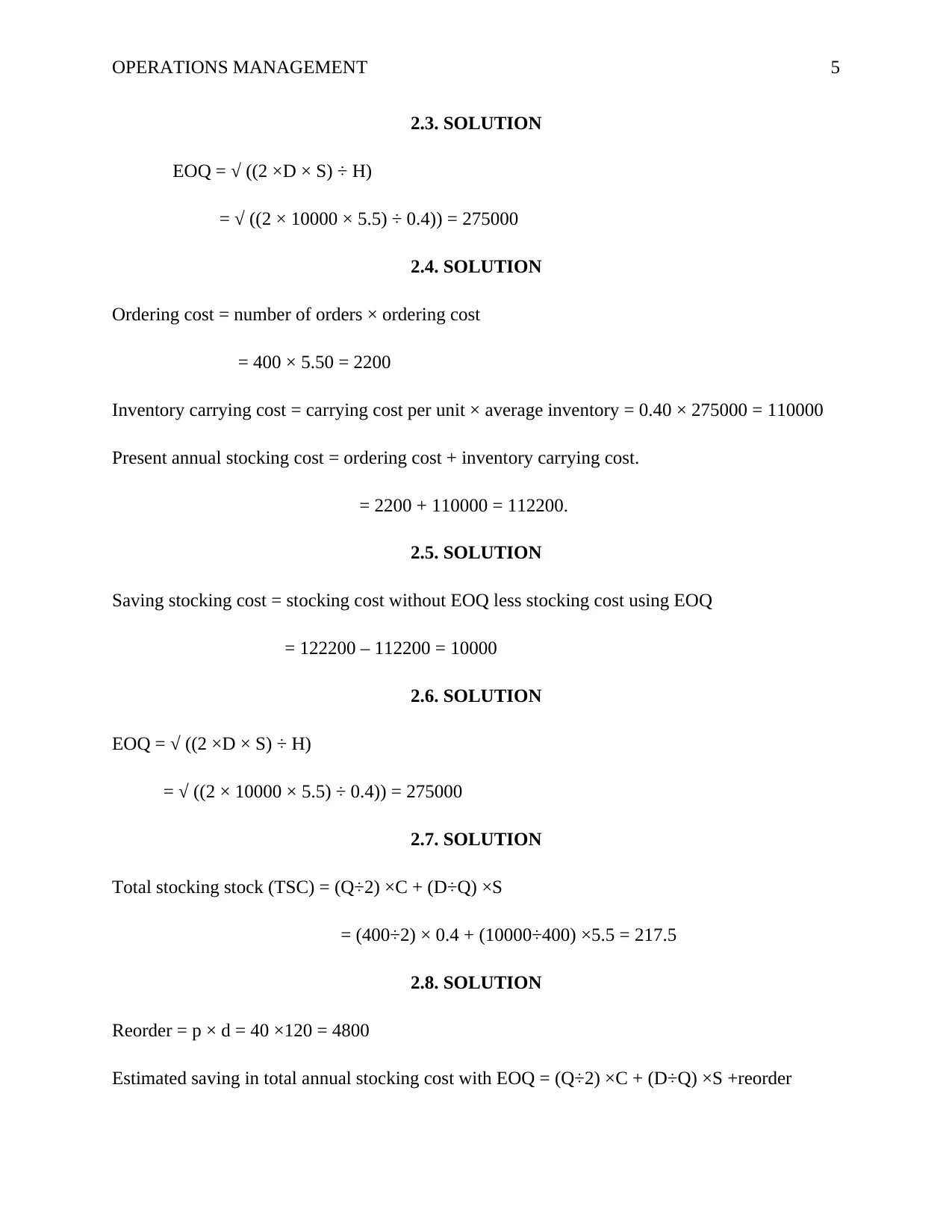
OPERATIONS MANAGEMENT 5
2.3. SOLUTION
EOQ = √ ((2 ×D × S) ÷ H)
= √ ((2 × 10000 × 5.5) ÷ 0.4)) = 275000
2.4. SOLUTION
Ordering cost = number of orders × ordering cost
= 400 × 5.50 = 2200
Inventory carrying cost = carrying cost per unit × average inventory = 0.40 × 275000 = 110000
Present annual stocking cost = ordering cost + inventory carrying cost.
= 2200 + 110000 = 112200.
2.5. SOLUTION
Saving stocking cost = stocking cost without EOQ less stocking cost using EOQ
= 122200 – 112200 = 10000
2.6. SOLUTION
EOQ = √ ((2 ×D × S) ÷ H)
= √ ((2 × 10000 × 5.5) ÷ 0.4)) = 275000
2.7. SOLUTION
Total stocking stock (TSC) = (Q÷2) ×C + (D÷Q) ×S
= (400÷2) × 0.4 + (10000÷400) ×5.5 = 217.5
2.8. SOLUTION
Reorder = p × d = 40 ×120 = 4800
Estimated saving in total annual stocking cost with EOQ = (Q÷2) ×C + (D÷Q) ×S +reorder
2.3. SOLUTION
EOQ = √ ((2 ×D × S) ÷ H)
= √ ((2 × 10000 × 5.5) ÷ 0.4)) = 275000
2.4. SOLUTION
Ordering cost = number of orders × ordering cost
= 400 × 5.50 = 2200
Inventory carrying cost = carrying cost per unit × average inventory = 0.40 × 275000 = 110000
Present annual stocking cost = ordering cost + inventory carrying cost.
= 2200 + 110000 = 112200.
2.5. SOLUTION
Saving stocking cost = stocking cost without EOQ less stocking cost using EOQ
= 122200 – 112200 = 10000
2.6. SOLUTION
EOQ = √ ((2 ×D × S) ÷ H)
= √ ((2 × 10000 × 5.5) ÷ 0.4)) = 275000
2.7. SOLUTION
Total stocking stock (TSC) = (Q÷2) ×C + (D÷Q) ×S
= (400÷2) × 0.4 + (10000÷400) ×5.5 = 217.5
2.8. SOLUTION
Reorder = p × d = 40 ×120 = 4800
Estimated saving in total annual stocking cost with EOQ = (Q÷2) ×C + (D÷Q) ×S +reorder
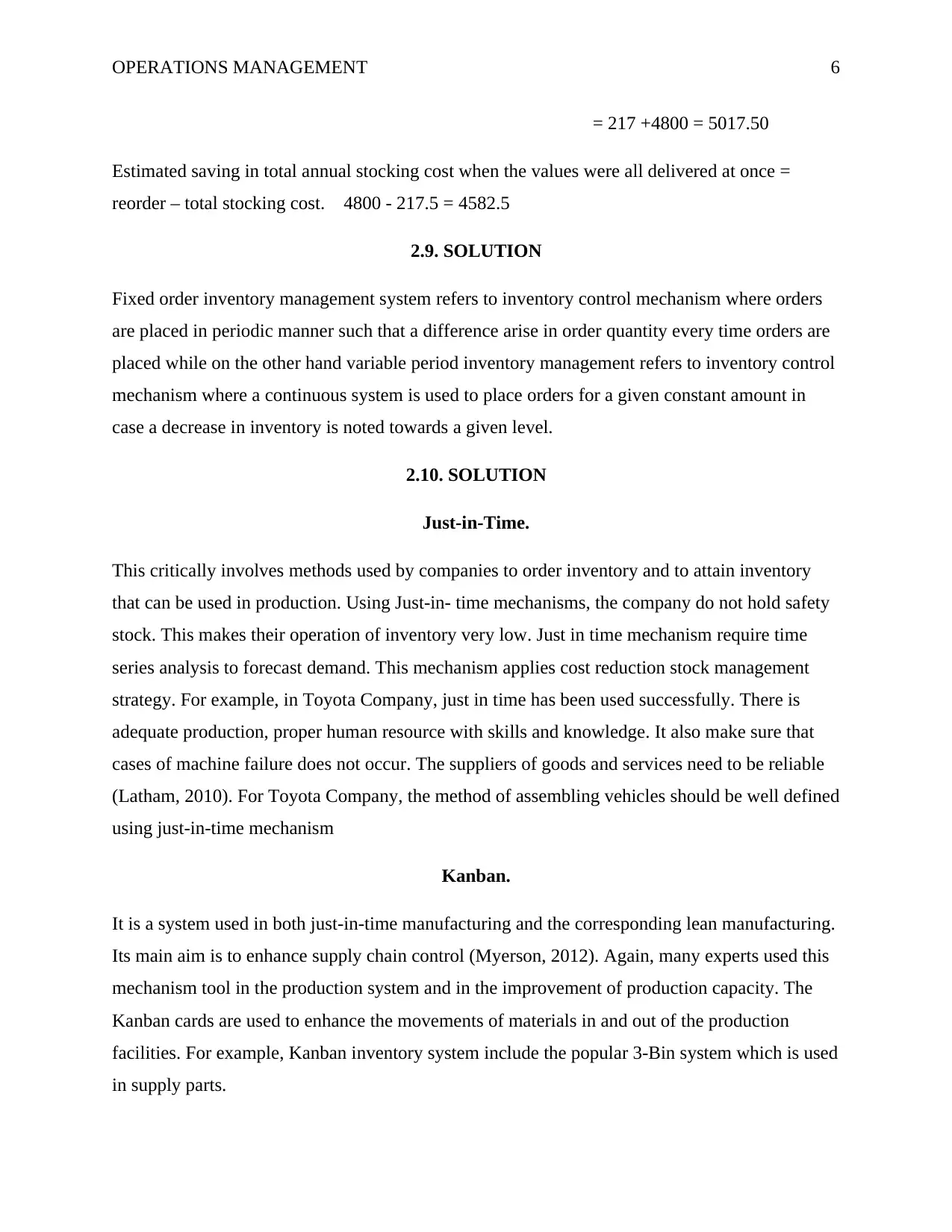
OPERATIONS MANAGEMENT 6
= 217 +4800 = 5017.50
Estimated saving in total annual stocking cost when the values were all delivered at once =
reorder – total stocking cost. 4800 - 217.5 = 4582.5
2.9. SOLUTION
Fixed order inventory management system refers to inventory control mechanism where orders
are placed in periodic manner such that a difference arise in order quantity every time orders are
placed while on the other hand variable period inventory management refers to inventory control
mechanism where a continuous system is used to place orders for a given constant amount in
case a decrease in inventory is noted towards a given level.
2.10. SOLUTION
Just-in-Time.
This critically involves methods used by companies to order inventory and to attain inventory
that can be used in production. Using Just-in- time mechanisms, the company do not hold safety
stock. This makes their operation of inventory very low. Just in time mechanism require time
series analysis to forecast demand. This mechanism applies cost reduction stock management
strategy. For example, in Toyota Company, just in time has been used successfully. There is
adequate production, proper human resource with skills and knowledge. It also make sure that
cases of machine failure does not occur. The suppliers of goods and services need to be reliable
(Latham, 2010). For Toyota Company, the method of assembling vehicles should be well defined
using just-in-time mechanism
Kanban.
It is a system used in both just-in-time manufacturing and the corresponding lean manufacturing.
Its main aim is to enhance supply chain control (Myerson, 2012). Again, many experts used this
mechanism tool in the production system and in the improvement of production capacity. The
Kanban cards are used to enhance the movements of materials in and out of the production
facilities. For example, Kanban inventory system include the popular 3-Bin system which is used
in supply parts.
= 217 +4800 = 5017.50
Estimated saving in total annual stocking cost when the values were all delivered at once =
reorder – total stocking cost. 4800 - 217.5 = 4582.5
2.9. SOLUTION
Fixed order inventory management system refers to inventory control mechanism where orders
are placed in periodic manner such that a difference arise in order quantity every time orders are
placed while on the other hand variable period inventory management refers to inventory control
mechanism where a continuous system is used to place orders for a given constant amount in
case a decrease in inventory is noted towards a given level.
2.10. SOLUTION
Just-in-Time.
This critically involves methods used by companies to order inventory and to attain inventory
that can be used in production. Using Just-in- time mechanisms, the company do not hold safety
stock. This makes their operation of inventory very low. Just in time mechanism require time
series analysis to forecast demand. This mechanism applies cost reduction stock management
strategy. For example, in Toyota Company, just in time has been used successfully. There is
adequate production, proper human resource with skills and knowledge. It also make sure that
cases of machine failure does not occur. The suppliers of goods and services need to be reliable
(Latham, 2010). For Toyota Company, the method of assembling vehicles should be well defined
using just-in-time mechanism
Kanban.
It is a system used in both just-in-time manufacturing and the corresponding lean manufacturing.
Its main aim is to enhance supply chain control (Myerson, 2012). Again, many experts used this
mechanism tool in the production system and in the improvement of production capacity. The
Kanban cards are used to enhance the movements of materials in and out of the production
facilities. For example, Kanban inventory system include the popular 3-Bin system which is used
in supply parts.
⊘ This is a preview!⊘
Do you want full access?
Subscribe today to unlock all pages.

Trusted by 1+ million students worldwide
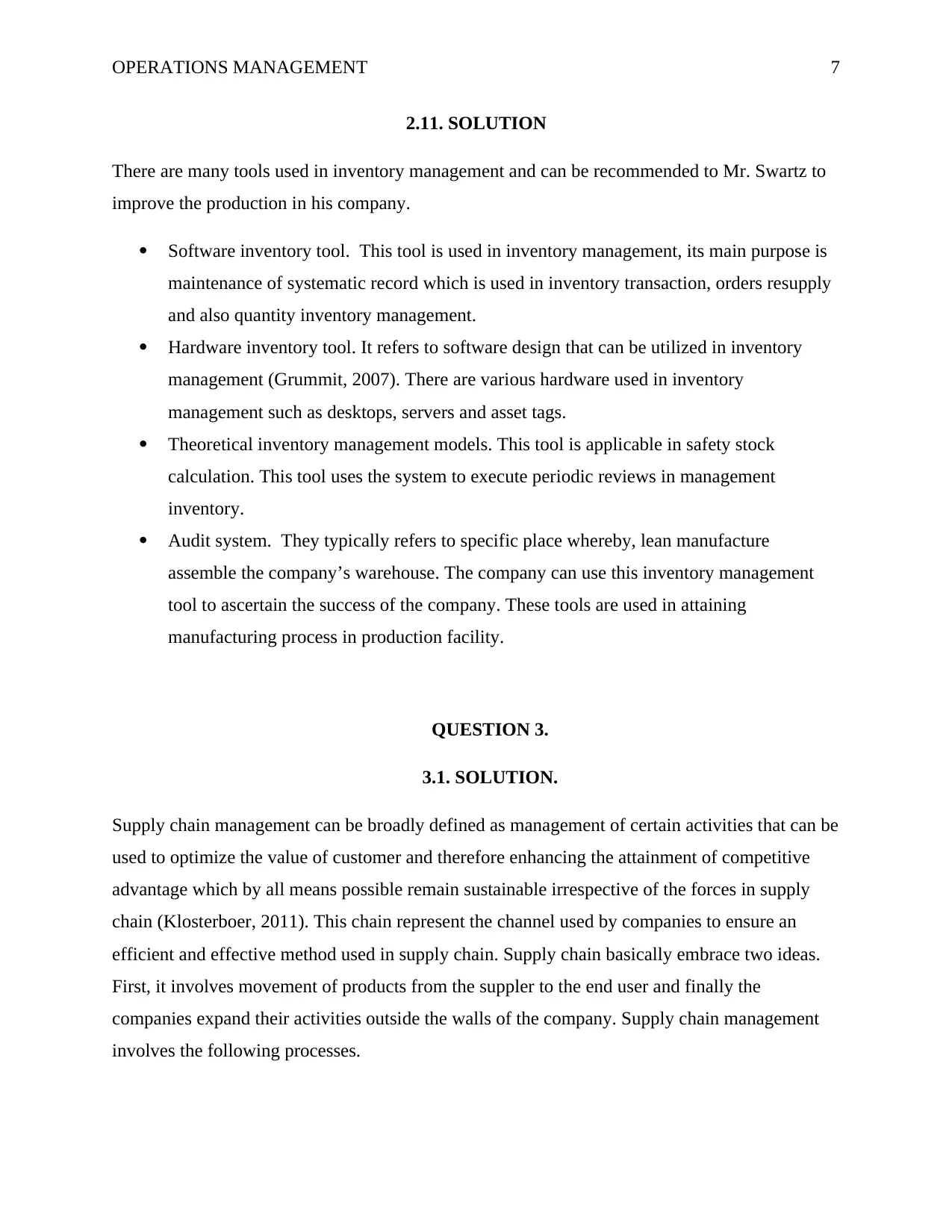
OPERATIONS MANAGEMENT 7
2.11. SOLUTION
There are many tools used in inventory management and can be recommended to Mr. Swartz to
improve the production in his company.
Software inventory tool. This tool is used in inventory management, its main purpose is
maintenance of systematic record which is used in inventory transaction, orders resupply
and also quantity inventory management.
Hardware inventory tool. It refers to software design that can be utilized in inventory
management (Grummit, 2007). There are various hardware used in inventory
management such as desktops, servers and asset tags.
Theoretical inventory management models. This tool is applicable in safety stock
calculation. This tool uses the system to execute periodic reviews in management
inventory.
Audit system. They typically refers to specific place whereby, lean manufacture
assemble the company’s warehouse. The company can use this inventory management
tool to ascertain the success of the company. These tools are used in attaining
manufacturing process in production facility.
QUESTION 3.
3.1. SOLUTION.
Supply chain management can be broadly defined as management of certain activities that can be
used to optimize the value of customer and therefore enhancing the attainment of competitive
advantage which by all means possible remain sustainable irrespective of the forces in supply
chain (Klosterboer, 2011). This chain represent the channel used by companies to ensure an
efficient and effective method used in supply chain. Supply chain basically embrace two ideas.
First, it involves movement of products from the suppler to the end user and finally the
companies expand their activities outside the walls of the company. Supply chain management
involves the following processes.
2.11. SOLUTION
There are many tools used in inventory management and can be recommended to Mr. Swartz to
improve the production in his company.
Software inventory tool. This tool is used in inventory management, its main purpose is
maintenance of systematic record which is used in inventory transaction, orders resupply
and also quantity inventory management.
Hardware inventory tool. It refers to software design that can be utilized in inventory
management (Grummit, 2007). There are various hardware used in inventory
management such as desktops, servers and asset tags.
Theoretical inventory management models. This tool is applicable in safety stock
calculation. This tool uses the system to execute periodic reviews in management
inventory.
Audit system. They typically refers to specific place whereby, lean manufacture
assemble the company’s warehouse. The company can use this inventory management
tool to ascertain the success of the company. These tools are used in attaining
manufacturing process in production facility.
QUESTION 3.
3.1. SOLUTION.
Supply chain management can be broadly defined as management of certain activities that can be
used to optimize the value of customer and therefore enhancing the attainment of competitive
advantage which by all means possible remain sustainable irrespective of the forces in supply
chain (Klosterboer, 2011). This chain represent the channel used by companies to ensure an
efficient and effective method used in supply chain. Supply chain basically embrace two ideas.
First, it involves movement of products from the suppler to the end user and finally the
companies expand their activities outside the walls of the company. Supply chain management
involves the following processes.
Paraphrase This Document
Need a fresh take? Get an instant paraphrase of this document with our AI Paraphraser
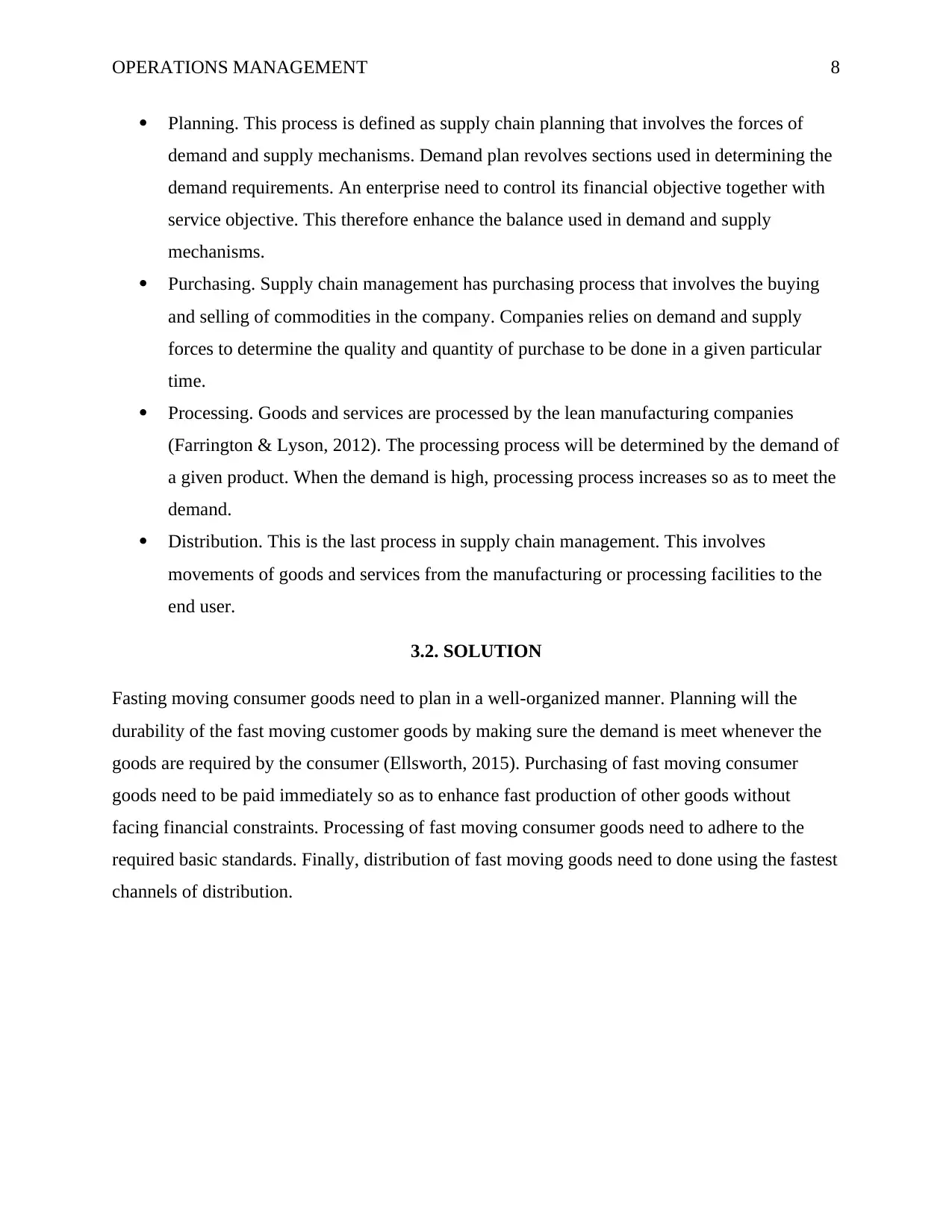
OPERATIONS MANAGEMENT 8
Planning. This process is defined as supply chain planning that involves the forces of
demand and supply mechanisms. Demand plan revolves sections used in determining the
demand requirements. An enterprise need to control its financial objective together with
service objective. This therefore enhance the balance used in demand and supply
mechanisms.
Purchasing. Supply chain management has purchasing process that involves the buying
and selling of commodities in the company. Companies relies on demand and supply
forces to determine the quality and quantity of purchase to be done in a given particular
time.
Processing. Goods and services are processed by the lean manufacturing companies
(Farrington & Lyson, 2012). The processing process will be determined by the demand of
a given product. When the demand is high, processing process increases so as to meet the
demand.
Distribution. This is the last process in supply chain management. This involves
movements of goods and services from the manufacturing or processing facilities to the
end user.
3.2. SOLUTION
Fasting moving consumer goods need to plan in a well-organized manner. Planning will the
durability of the fast moving customer goods by making sure the demand is meet whenever the
goods are required by the consumer (Ellsworth, 2015). Purchasing of fast moving consumer
goods need to be paid immediately so as to enhance fast production of other goods without
facing financial constraints. Processing of fast moving consumer goods need to adhere to the
required basic standards. Finally, distribution of fast moving goods need to done using the fastest
channels of distribution.
Planning. This process is defined as supply chain planning that involves the forces of
demand and supply mechanisms. Demand plan revolves sections used in determining the
demand requirements. An enterprise need to control its financial objective together with
service objective. This therefore enhance the balance used in demand and supply
mechanisms.
Purchasing. Supply chain management has purchasing process that involves the buying
and selling of commodities in the company. Companies relies on demand and supply
forces to determine the quality and quantity of purchase to be done in a given particular
time.
Processing. Goods and services are processed by the lean manufacturing companies
(Farrington & Lyson, 2012). The processing process will be determined by the demand of
a given product. When the demand is high, processing process increases so as to meet the
demand.
Distribution. This is the last process in supply chain management. This involves
movements of goods and services from the manufacturing or processing facilities to the
end user.
3.2. SOLUTION
Fasting moving consumer goods need to plan in a well-organized manner. Planning will the
durability of the fast moving customer goods by making sure the demand is meet whenever the
goods are required by the consumer (Ellsworth, 2015). Purchasing of fast moving consumer
goods need to be paid immediately so as to enhance fast production of other goods without
facing financial constraints. Processing of fast moving consumer goods need to adhere to the
required basic standards. Finally, distribution of fast moving goods need to done using the fastest
channels of distribution.
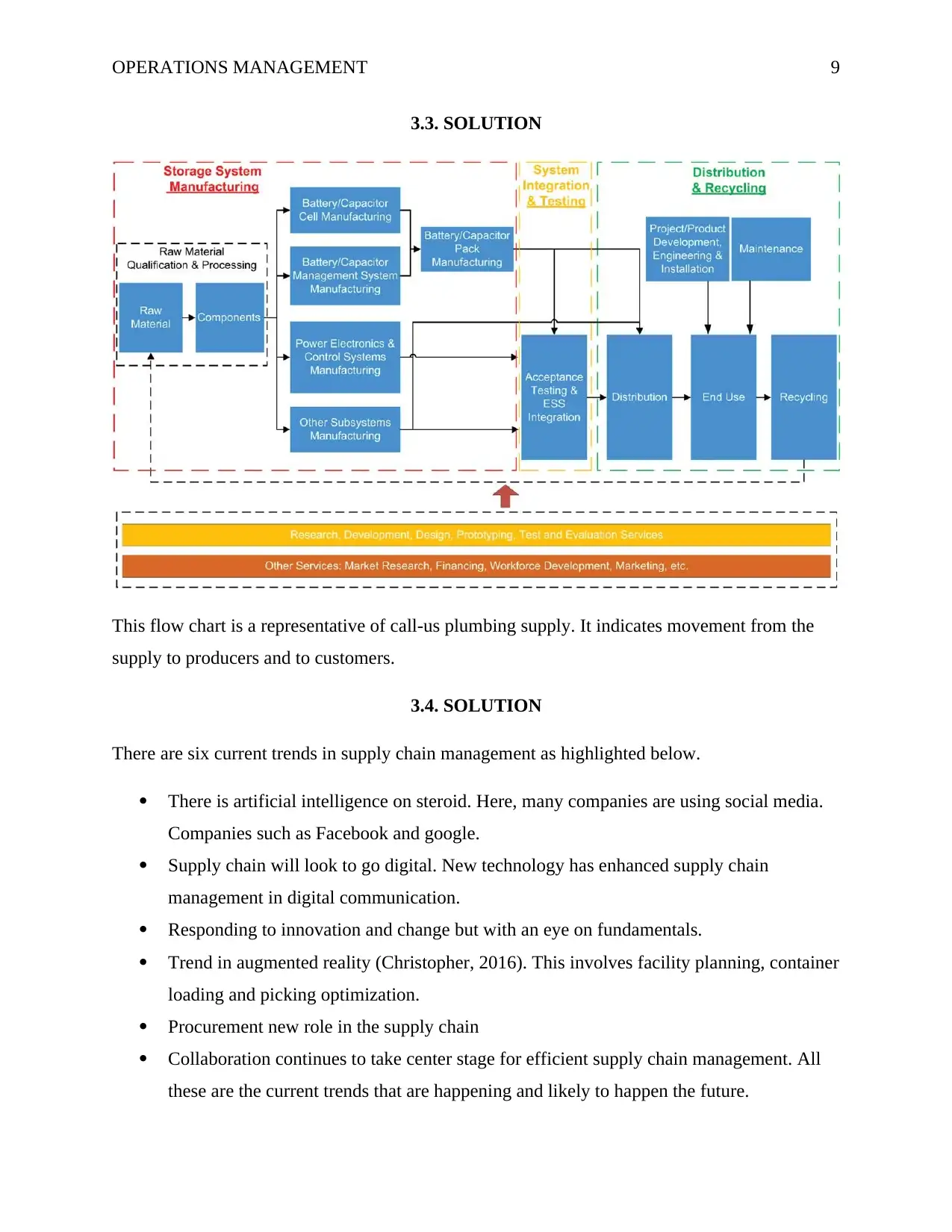
OPERATIONS MANAGEMENT 9
3.3. SOLUTION
This flow chart is a representative of call-us plumbing supply. It indicates movement from the
supply to producers and to customers.
3.4. SOLUTION
There are six current trends in supply chain management as highlighted below.
There is artificial intelligence on steroid. Here, many companies are using social media.
Companies such as Facebook and google.
Supply chain will look to go digital. New technology has enhanced supply chain
management in digital communication.
Responding to innovation and change but with an eye on fundamentals.
Trend in augmented reality (Christopher, 2016). This involves facility planning, container
loading and picking optimization.
Procurement new role in the supply chain
Collaboration continues to take center stage for efficient supply chain management. All
these are the current trends that are happening and likely to happen the future.
3.3. SOLUTION
This flow chart is a representative of call-us plumbing supply. It indicates movement from the
supply to producers and to customers.
3.4. SOLUTION
There are six current trends in supply chain management as highlighted below.
There is artificial intelligence on steroid. Here, many companies are using social media.
Companies such as Facebook and google.
Supply chain will look to go digital. New technology has enhanced supply chain
management in digital communication.
Responding to innovation and change but with an eye on fundamentals.
Trend in augmented reality (Christopher, 2016). This involves facility planning, container
loading and picking optimization.
Procurement new role in the supply chain
Collaboration continues to take center stage for efficient supply chain management. All
these are the current trends that are happening and likely to happen the future.
⊘ This is a preview!⊘
Do you want full access?
Subscribe today to unlock all pages.

Trusted by 1+ million students worldwide
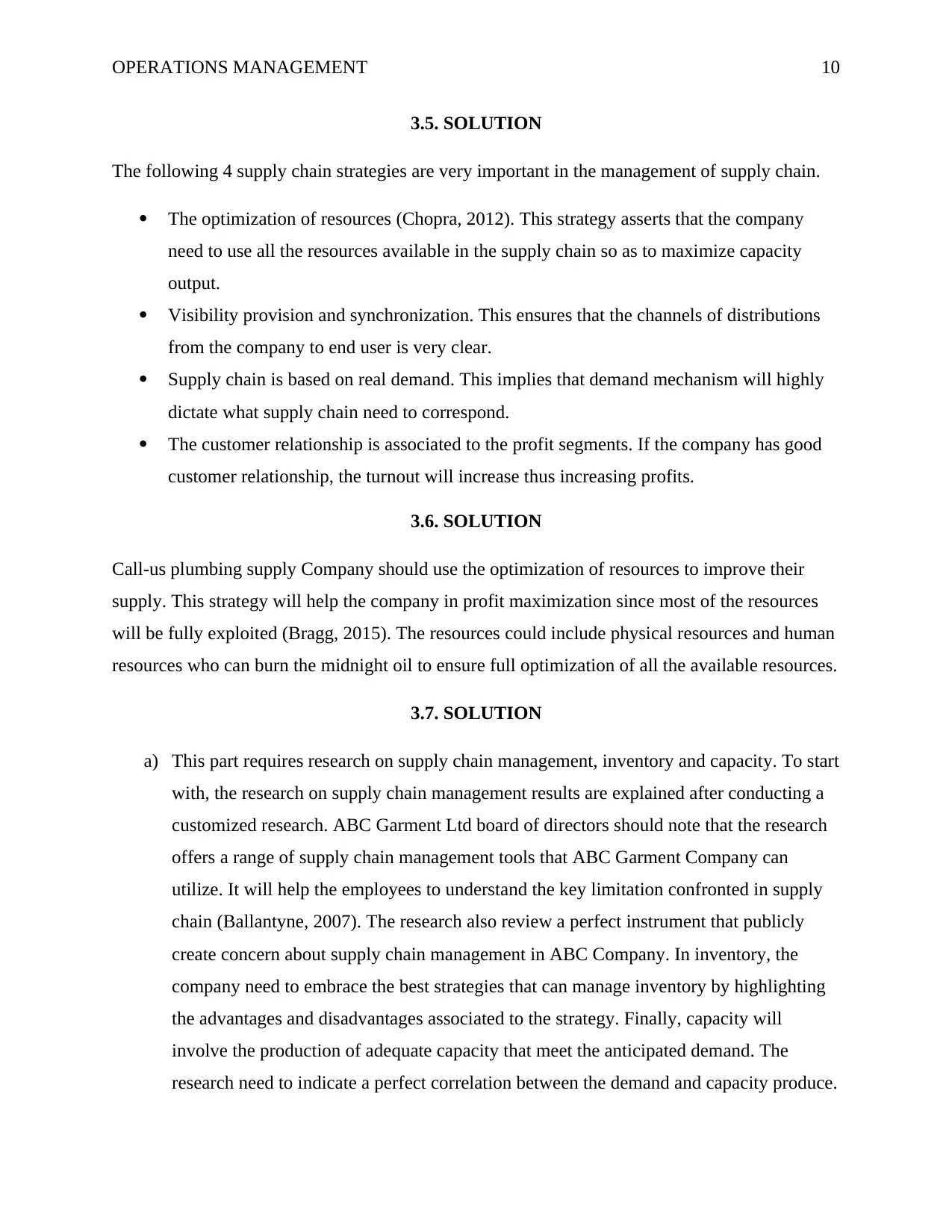
OPERATIONS MANAGEMENT 10
3.5. SOLUTION
The following 4 supply chain strategies are very important in the management of supply chain.
The optimization of resources (Chopra, 2012). This strategy asserts that the company
need to use all the resources available in the supply chain so as to maximize capacity
output.
Visibility provision and synchronization. This ensures that the channels of distributions
from the company to end user is very clear.
Supply chain is based on real demand. This implies that demand mechanism will highly
dictate what supply chain need to correspond.
The customer relationship is associated to the profit segments. If the company has good
customer relationship, the turnout will increase thus increasing profits.
3.6. SOLUTION
Call-us plumbing supply Company should use the optimization of resources to improve their
supply. This strategy will help the company in profit maximization since most of the resources
will be fully exploited (Bragg, 2015). The resources could include physical resources and human
resources who can burn the midnight oil to ensure full optimization of all the available resources.
3.7. SOLUTION
a) This part requires research on supply chain management, inventory and capacity. To start
with, the research on supply chain management results are explained after conducting a
customized research. ABC Garment Ltd board of directors should note that the research
offers a range of supply chain management tools that ABC Garment Company can
utilize. It will help the employees to understand the key limitation confronted in supply
chain (Ballantyne, 2007). The research also review a perfect instrument that publicly
create concern about supply chain management in ABC Company. In inventory, the
company need to embrace the best strategies that can manage inventory by highlighting
the advantages and disadvantages associated to the strategy. Finally, capacity will
involve the production of adequate capacity that meet the anticipated demand. The
research need to indicate a perfect correlation between the demand and capacity produce.
3.5. SOLUTION
The following 4 supply chain strategies are very important in the management of supply chain.
The optimization of resources (Chopra, 2012). This strategy asserts that the company
need to use all the resources available in the supply chain so as to maximize capacity
output.
Visibility provision and synchronization. This ensures that the channels of distributions
from the company to end user is very clear.
Supply chain is based on real demand. This implies that demand mechanism will highly
dictate what supply chain need to correspond.
The customer relationship is associated to the profit segments. If the company has good
customer relationship, the turnout will increase thus increasing profits.
3.6. SOLUTION
Call-us plumbing supply Company should use the optimization of resources to improve their
supply. This strategy will help the company in profit maximization since most of the resources
will be fully exploited (Bragg, 2015). The resources could include physical resources and human
resources who can burn the midnight oil to ensure full optimization of all the available resources.
3.7. SOLUTION
a) This part requires research on supply chain management, inventory and capacity. To start
with, the research on supply chain management results are explained after conducting a
customized research. ABC Garment Ltd board of directors should note that the research
offers a range of supply chain management tools that ABC Garment Company can
utilize. It will help the employees to understand the key limitation confronted in supply
chain (Ballantyne, 2007). The research also review a perfect instrument that publicly
create concern about supply chain management in ABC Company. In inventory, the
company need to embrace the best strategies that can manage inventory by highlighting
the advantages and disadvantages associated to the strategy. Finally, capacity will
involve the production of adequate capacity that meet the anticipated demand. The
research need to indicate a perfect correlation between the demand and capacity produce.
Paraphrase This Document
Need a fresh take? Get an instant paraphrase of this document with our AI Paraphraser
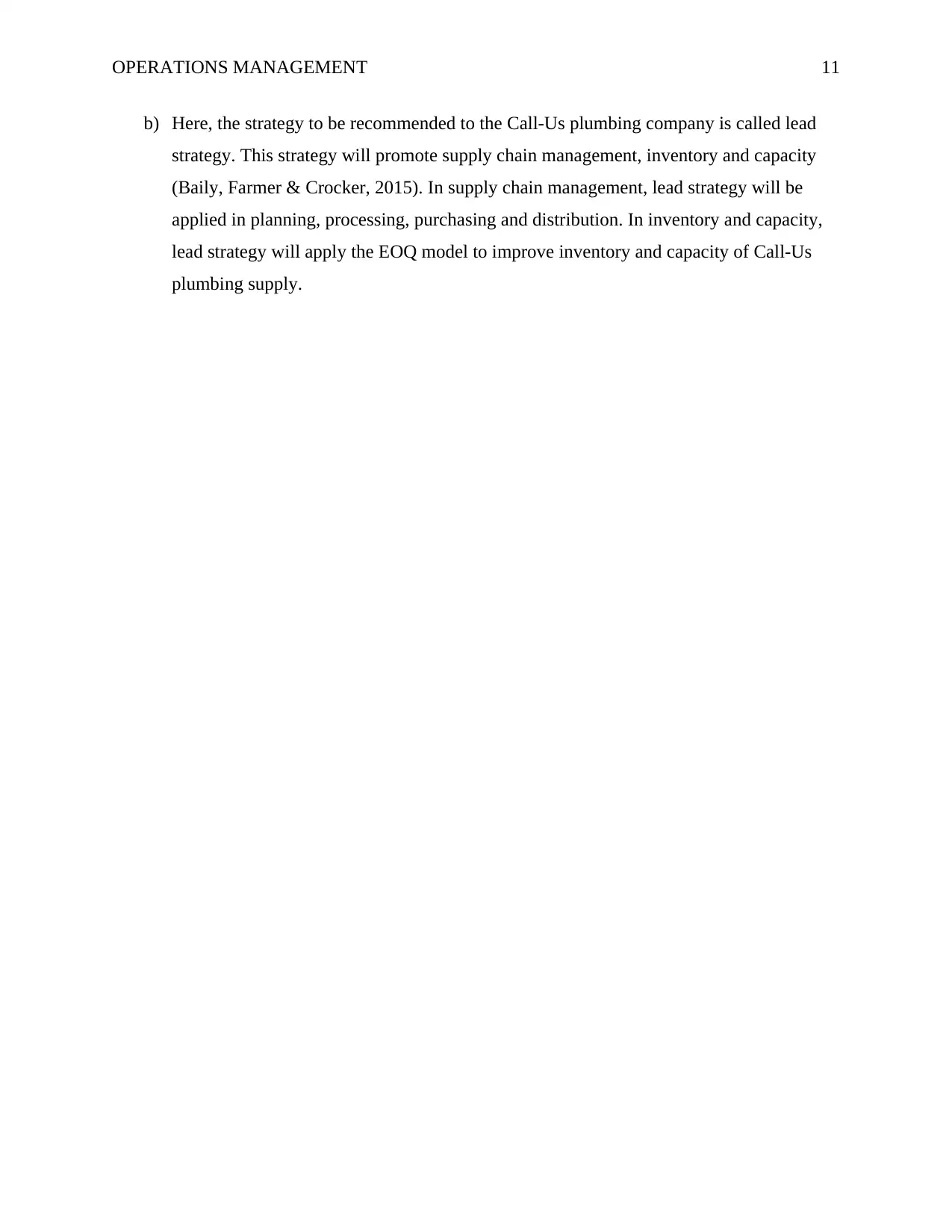
OPERATIONS MANAGEMENT 11
b) Here, the strategy to be recommended to the Call-Us plumbing company is called lead
strategy. This strategy will promote supply chain management, inventory and capacity
(Baily, Farmer & Crocker, 2015). In supply chain management, lead strategy will be
applied in planning, processing, purchasing and distribution. In inventory and capacity,
lead strategy will apply the EOQ model to improve inventory and capacity of Call-Us
plumbing supply.
b) Here, the strategy to be recommended to the Call-Us plumbing company is called lead
strategy. This strategy will promote supply chain management, inventory and capacity
(Baily, Farmer & Crocker, 2015). In supply chain management, lead strategy will be
applied in planning, processing, purchasing and distribution. In inventory and capacity,
lead strategy will apply the EOQ model to improve inventory and capacity of Call-Us
plumbing supply.
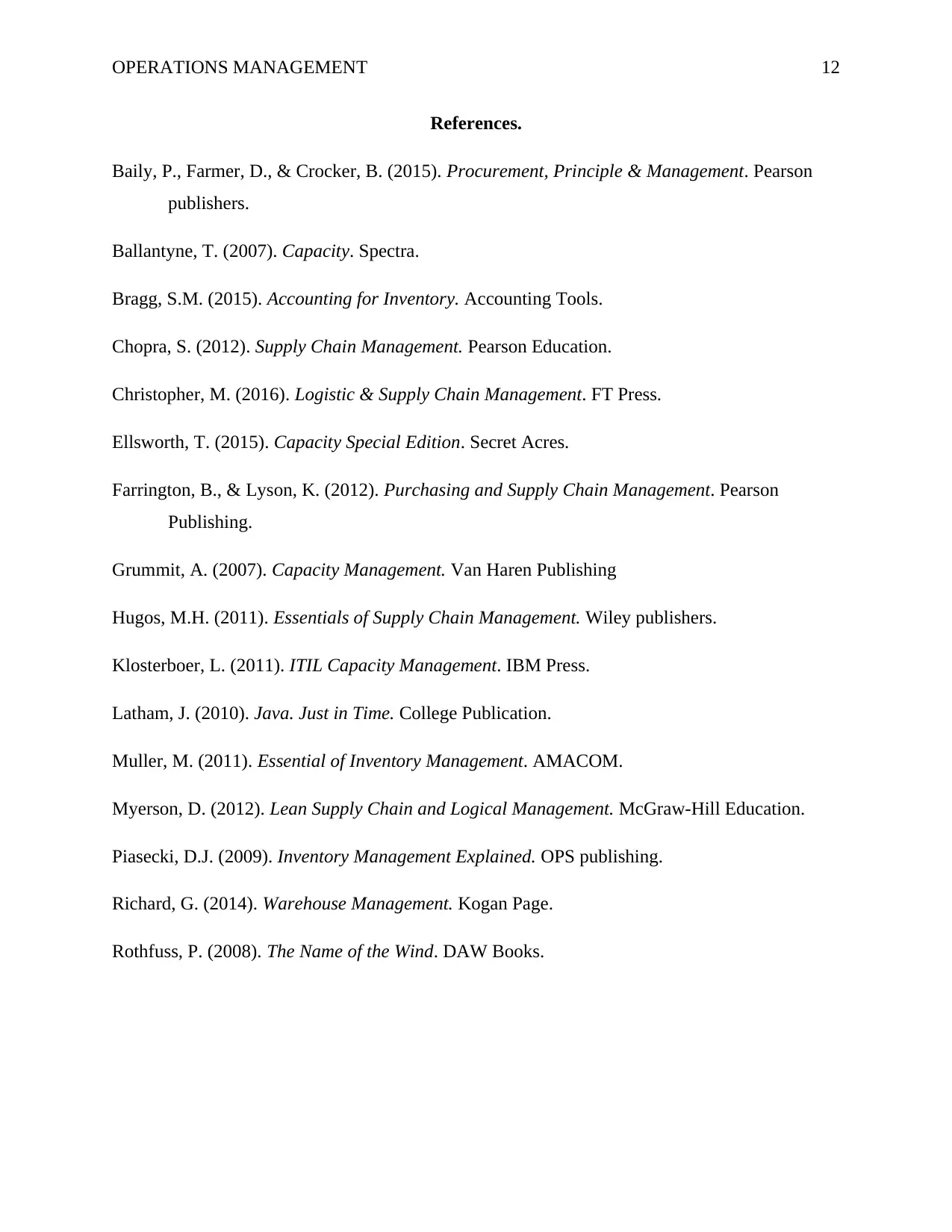
OPERATIONS MANAGEMENT 12
References.
Baily, P., Farmer, D., & Crocker, B. (2015). Procurement, Principle & Management. Pearson
publishers.
Ballantyne, T. (2007). Capacity. Spectra.
Bragg, S.M. (2015). Accounting for Inventory. Accounting Tools.
Chopra, S. (2012). Supply Chain Management. Pearson Education.
Christopher, M. (2016). Logistic & Supply Chain Management. FT Press.
Ellsworth, T. (2015). Capacity Special Edition. Secret Acres.
Farrington, B., & Lyson, K. (2012). Purchasing and Supply Chain Management. Pearson
Publishing.
Grummit, A. (2007). Capacity Management. Van Haren Publishing
Hugos, M.H. (2011). Essentials of Supply Chain Management. Wiley publishers.
Klosterboer, L. (2011). ITIL Capacity Management. IBM Press.
Latham, J. (2010). Java. Just in Time. College Publication.
Muller, M. (2011). Essential of Inventory Management. AMACOM.
Myerson, D. (2012). Lean Supply Chain and Logical Management. McGraw-Hill Education.
Piasecki, D.J. (2009). Inventory Management Explained. OPS publishing.
Richard, G. (2014). Warehouse Management. Kogan Page.
Rothfuss, P. (2008). The Name of the Wind. DAW Books.
References.
Baily, P., Farmer, D., & Crocker, B. (2015). Procurement, Principle & Management. Pearson
publishers.
Ballantyne, T. (2007). Capacity. Spectra.
Bragg, S.M. (2015). Accounting for Inventory. Accounting Tools.
Chopra, S. (2012). Supply Chain Management. Pearson Education.
Christopher, M. (2016). Logistic & Supply Chain Management. FT Press.
Ellsworth, T. (2015). Capacity Special Edition. Secret Acres.
Farrington, B., & Lyson, K. (2012). Purchasing and Supply Chain Management. Pearson
Publishing.
Grummit, A. (2007). Capacity Management. Van Haren Publishing
Hugos, M.H. (2011). Essentials of Supply Chain Management. Wiley publishers.
Klosterboer, L. (2011). ITIL Capacity Management. IBM Press.
Latham, J. (2010). Java. Just in Time. College Publication.
Muller, M. (2011). Essential of Inventory Management. AMACOM.
Myerson, D. (2012). Lean Supply Chain and Logical Management. McGraw-Hill Education.
Piasecki, D.J. (2009). Inventory Management Explained. OPS publishing.
Richard, G. (2014). Warehouse Management. Kogan Page.
Rothfuss, P. (2008). The Name of the Wind. DAW Books.
⊘ This is a preview!⊘
Do you want full access?
Subscribe today to unlock all pages.

Trusted by 1+ million students worldwide
1 out of 12
Related Documents
Your All-in-One AI-Powered Toolkit for Academic Success.
+13062052269
info@desklib.com
Available 24*7 on WhatsApp / Email
![[object Object]](/_next/static/media/star-bottom.7253800d.svg)
Unlock your academic potential
Copyright © 2020–2025 A2Z Services. All Rights Reserved. Developed and managed by ZUCOL.





